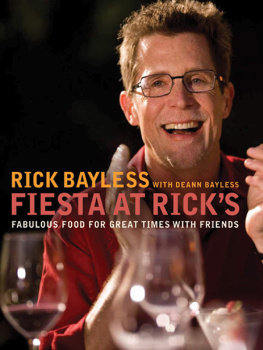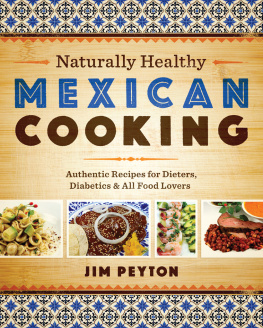Note: Most of the recipes in this book include raw fish. When fish is consumed raw, there is always the risk that bacteria may be present. For this reason, always buy the freshest fish available from a reliable fishmonger, storing it in the refrigerator until it is served. Because of health risks associated with the consumption of bacteria that can be present in raw fish, these foods should not be consumed by infants, small children, pregnant women, the elderly, or any people who may be immunocompromised.
Copyright 2003, 2010 by Douglas Rodriguez
Photographs copyright 2002 by Christopher Hirsheimer
Photographs of a
copyright 2010 by Chugrad McAndrews
All rights reserved.
Published in the United States by Ten Speed Press, an imprint of the Crown Publishing Group, a division of Random House, Inc., New York.
www.crownpublishing.com
www.tenspeed.com
Ten Speed Press and the Ten Speed Press colophon are registered trademarks of Random House, Inc.
A previous edition of this work was published in the United States by Ten Speed Press, Berkeley, CA, in 2003.
Library of Congress Cataloging-in-Publication Data
Rodriguez, Douglas.
The great ceviche book / Douglas Rodriguez with Laura Zimmerman ; photography by Christopher Hirsheimer and Chugrad McAndrews ; [foreword by Calvin Trillin]. Rev. ed.
p. cm.
Includes index.
1. Cookery (Seafood) 2. Cookery (Cold dishes)
3. Cookery, Latin American. I. Zimmerman, Laura. II. Title.
TX747.R635 2010
641.598dc22
2009049570
eISBN: 978-1-60774-455-9
Design by Toni Tajima
Food and prop styling in the following photographs: a by Jenny Martin-Wong
Props used in remaining photographs courtesy of Apartment 48 Home Furnishings, New York
Seafood used in remaining photographs courtesy of Pacifica International and M. Slavin & Sons, New York
Revised Edition
v3.1
CONTENTS
ACKNOWLEDGMENTS
Inspiration may come to you in many different ways.
But most often it comes to me in my travels, away from my day to day routinewhen Im in a relaxed mode. Often this happens when I take culinary trips with other chefs, friends, colleagues, and employees.
So first I would like thank my chefs, colleagues, and employeesthose who keep my creative wheels turning. Chef Jose-Luis Flores, thank you for your friendship, loyalty, and inspiration. I would like to thank Roberto Madrid, Darren Carbone, David Laforce, and Horacio Riveradero for their support.
I also want to give thanks to those who are on their own: Jose Garces (the Iron Chef), Raymond Mohan, Ramiro Jimenez, Maximo Tejeda, and Adrian Leon.
As always, Felipe Rojas Lombardi, who inspired me from an early age and taught me the power of spreading the word of the Latin table.
My editor, Annie Nelson, and all my friends at Ten Speed Press. A special thanks to Phil Wood, for his patience, gentle pressure, and encouragement in this, my fourth book. May our adventures together allow for more storytelling and idea sharing.
Christopher Hirsheimer and Chugrad McAndrews, for contributing the beautiful photographs for this book.
Laura Zimmerman, my coauthor, for researching, organizing, and fine-tuning the text and putting my voice so accurately into written words.
Dr. Joe Regenstein, of Cornell Universitys Food Science Department, and Dr. Robert Price, of the University of California, Daviss Food Science and Technology Department, for furthering my knowledge of seafood safety, specifically in reference to home preparation.
Many of my chef friends and seafood suppliers across the country who helped me put together the very useful seafood sources guide in the back of this book.
My mom, my dad, and my brother, Frank, for their love and support and many good times around the dinner table.
My kids, Victoria, Leandro, and Dario, who are happy to eat mac and cheese. Hopefully one day you guys will eat ceviche.
FOREWORD by Calvin Trillin
Douglas Rodriguez is not someone you could accuse of lacking enthusiasm for his calling.
The first time I went to see him, what I had in mind was simply getting some suggestions about where to eat ceviche. I had no idea that he was going to get himself all worked up. A few years before this, I had spent some time in Ecuador, and to say that Id become fond of Ecuadorian ceviche would be like saying that Gauguin, when he got to Tahiti, found himself reasonably impressed by the native women. When I began planning a return to that part of South America in order to do an article on ceviche, I figured it made sense to begin by consulting with the man who, first at Patria and then at Chicama, had brought ceviche into the Manhattan mainstream.
Douglas and I were sitting at a table at Chicama, which, he reminded me, had been named for a coastal village in Peru, a country whose ceviche is sometimes thought of as rather formal or even stately. Then he started talking about Peruvian ceviche, which is chunks of cured fish and spices and onions, always flanked by wedges of potato or corn. As he warmed to the subject, he moved from the classic Peruvian ceviche to tiraditoa form of the dish in which the fish is cut into slices, more or less like sashimi. That got him into a description of the man he considered the master of Peruvian ceviche, a legendary Lima chef named Humberto Sato. Douglas discussed Sato with something approaching reverence, as if discussing some sort of Zen master, and when he told me Id have to visit Satos restaurant, Costanera 700, he fairly glowed with the memory of his own most recent meal there.
Then Douglas got started on the ceviche of Ecuador, which sounded like his favorite, since he seemed to become even more animated as he described how it differed from the ceviche in Peru. Like ceviche elsewhere in Latin America, Ecuadorian ceviche is made by curing fresh fish in the juice of a particularly acid lemon. Unlike any ceviche Id had before I visited Ecuador, though, it includes enough of the curing juices to be sort of liquid; its served in a bowl rather than on a plate. Large roasted kernels of Andean corn are served on the side, to be tossed in for both flavor and crunch. Some restaurants offer as accompaniment not only roasted corn kernels but popcorn.
Douglas mentioned some restaurants in Quito and Guayaquil, but quickly moved on to Salinas, on Ecuadors westernmost coast. He got more and more excited as he talked about the clusters of cevicherias and particularly a place called La Lojanita, whose ceviche was of such high quality, he said, that the proprietor had been elected mayor. As he described La Lojanitaor Mecca, as he sometimes called ithe was getting more and more excited. Finally, he paused for a moment, nodded his head as if hed just come to a decision and practically shouted, Im going with you!
He did. Or, at least, our parties met up in Guayaquil, and, for a few days become what I referred to in the article as the ceviche gang, an eating posse of seven or eight people moving through a section of western Ecuador cevicherias. By the time we finally reached La Lojanita, only three or four of us still felt capable of bellying up to its counter, but Douglass order didnt seem to be affected by the reduced number of eaters. In front of us were about twenty bowls of ceviche. In my memory of that moment at La Lojanita, Douglas is praising the octopus while reaching for the black clam and questioning the countermen closely on whether weve missed anything. He had gotten himself all worked up.












